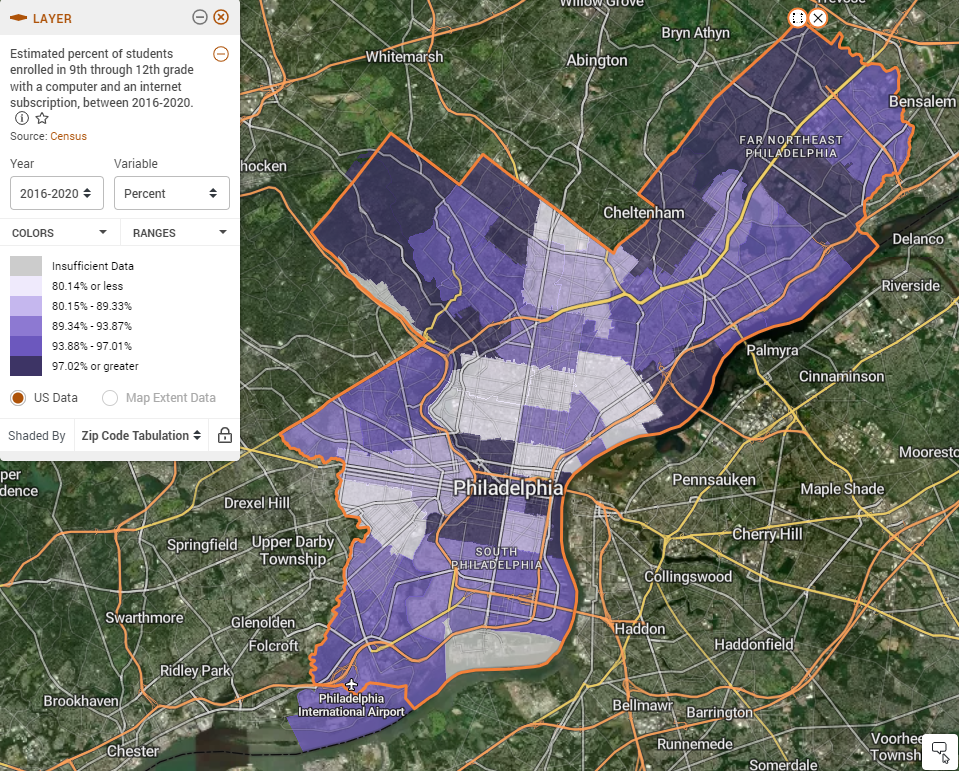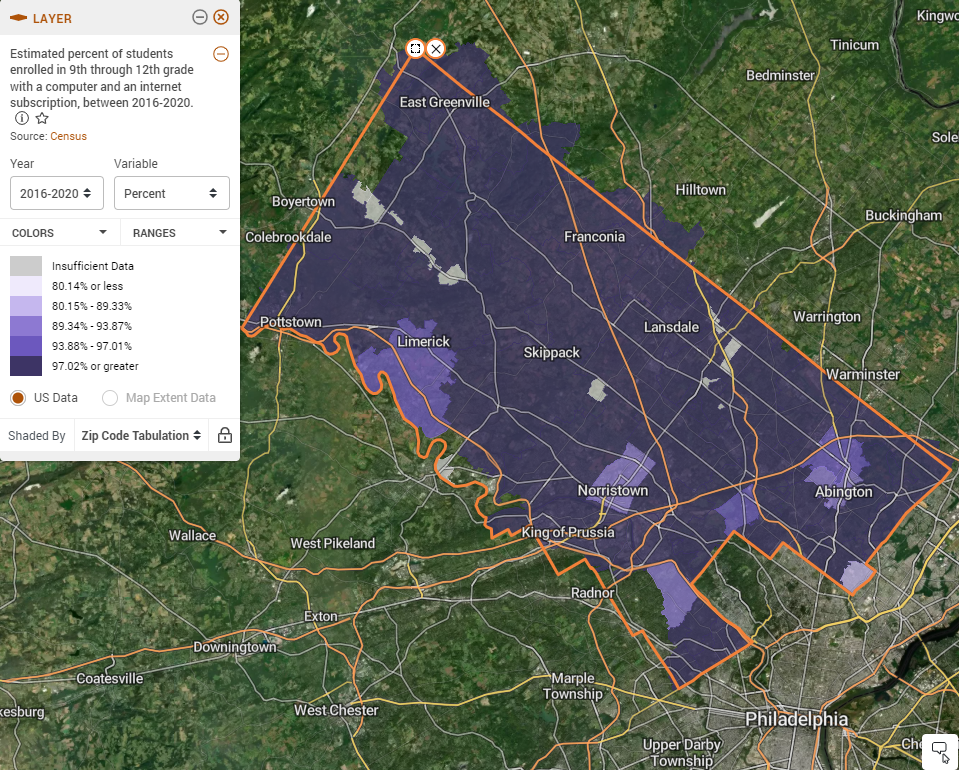Understand Grade-Schoolers’ Internet and Computer Access in an Era of Remote Education Using New ACS Data

Data
CDC PLACES
Source
Centers for Disease Control and Prevention (CDC)
Find on PolicyMap
- Health
- Risk Factors
In an era of virtual schooling and online homework, access to high-speed internet and a household computer is crucial to the successful education of millions of American schoolchildren. Grade-schoolers’ computer and the internet access were particularly essential during the two-year period of remote instruction during the height of the COVID-19 pandemic. However, families in many lower-income communities may struggle to afford the high upfront cost of a computer, or ongoing financial burden of monthly internet bills.
PolicyMap users can now access 5-year estimates from the 2016-2020 ACS datasets on “Computer & Internet Access by Grade”, separated into four categories, including: Pre-K – 4th Grade, 5th Grade – 8th Grade, 9th Grade – 12th Grade, and Undergraduate or Higher. With this newly available data, users will be able to examine the rural-urban divide in internet and computer access, analyze the discrepancy in access among low-income communities, and understand the potential effects of government policies that expand infrastructure and provide affordable internet plans.
The Rural-Urban Divide in Internet and Computer Access
One might assume that the “Rural-Urban Divide” in broadband access mean that urban communities have greater access to the internet the rural communities, but this is not the case. According to the New York Times’ 2021 analysis of Census Bureau data from 2018, 86% of urban households had access to the internet, compared to only 81% of rural households – but that as 13.6 million urban households are without internet, compared to the only 4.6 million rural households without internet, it is urban communities who have a greater lack in internet access. A lack of internet access in rural communities is problematic, but its existence is understandable: broadband infrastructure simply does not reach many rural households. So, why then, do so many urban households not have internet or computer access?
The Census Bureau’s new dataset on Computer & Internet Access by Grade, now available on PolicyMap, exclusively focuses on students’ internet and computer access, pre-K through college. The City of Philadelphia and two surrounding counties in the Commonwealth of Pennsylvania show a clear example of the rural-urban divide in internet and computer access. Let us look at the following maps of Philadelphia County, Lancaster County, and Montgomery County show the percent of 9th-12th graders with internet access, by Zip Code Tabulation.

In Philadelphia’s Center City and many of it’s suburban outskirts, almost every single household has internet and computer access. However, many of the city’s lower income neighborhoods have far more limited access. In many zip codes, fewer than 80% of students have access – this shows that during the pandemic, 1 in 5 high schoolers did not have access to virtual school.

Lancaster County, a rural county with several smaller cities, also experienced a lack of internet and computer access. Suburban communities and some cities had almost-universal access, whereas many rural, agricultural zip codes had as few as 40% of students with internet and computer access.

Now, compare the previous two counties to Montgomery County, a wealthy, suburban community. Nearly every student in the county has computer and internet access, with only a few low points in some of the county’s major cities. Perhaps rural and urban communities face many of the same issues in lack of access; issues not faced by wealthier suburban neighborhoods.

Internet & Computer Access in Philadelphia County by Zip Code, 9th-12th Grade.

Poverty Rate of Single-Parent Headed Families with Children by Zip Code
Let us revisit the first map, of internet and computer access by zip code among 9th-12th graders in the City of Philadelphia. Now, compare it to the following map, the poverty rate of single-parent headed families with children. Notice the striking similarity between the pair of maps. A regression analysis would almost certainly find a strong correlation between poverty in single-headed families with children, and a lack of internet and computer access. Thus, while rural communities may have limited access due to a lack of broadband infrastructure, poverty is a significant driver of limited internet and computer access in urban communities. But regardless of where students live, their inability to access the internet may be detrimental to their educational performance, and this is a problem that should be remedied.
Policy Solutions in Infrastructure Expansion and Affordable Internet Programs
As a final note, the government does have many programs in place to expand internet and computer access, but as shown by this new dataset, countless students still do not have access to the internet, which may impair their ability to attend class or complete assignments. Federal and state governments frequently invest in the expansion of broadband infrastructure, in cooperation with internet providers. Census Bureau data on internet access can help provide targeted investment in the communities that need internet infrastructure.
However, simply building more internet cables does not solve the disparity in access as seen in low-income urban communities. The FCC’s Affordable Connectively Program provides impoverished households with $30/month discounts towards their internet plans, and a one-time $100 discount to computer and tablet purchases. The City of Philadelphia takes this program one step further: their PHLConnectED program provides more than 18,000 households with free internet access to low-income families, particularly focusing on families with children. Both of these programs are new government initiatives created in response to the pandemic, are and providing assistance to many Americans – especially students – in need of internet access. As the Census Bureau continues to update its data, PolicyMap’s new “Computer & Internet Access by Grade” will allow the user to analyze the effects these internet access policies have on students across the country.
Interested in learning more about accessing ACS data? Contact us.